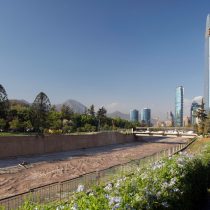
In the 1990s, the water quality of the Mapocho River was a big problem. With odors, floods, seagulls and being a focus of diseases through its untreated channels, the river had serious impacts on the environment and society.
His change has now been impressive. With clean, odorless and decontaminated waters, the river crosses the city with truly clean waters. Although its brown appearance will never change because the color of the soil, land and stones are common in the rivers of Chile, today the Mapocho receives no discharges of sewage.
The Mapocho Urbano Limpio project was carried out by the concessionaire of the Aguas Andinas drinking water system between 2007 and 2010, with the idea of producing a significant change not only in the largest river in the capital, but also in the Maipo River, the Zanjón de la Aguada and the San Carlos canal, among others. Among his greatest achievements was the creation of La Farfana and El Trebal, plants located in the west area that convert sewage into clean energy. Its investment has been more than $1.2 billion making it one of the largest environmental advances in the country.
Compared to what was previously the sanitation system with what it is now, in 1999 only 3% of sewage was decontaminated, currently amounting to 100% making Chile the first capital in Latin America to have drinking water, sewerage and wastewater treatment coverage in its entirety.
Juan Eduardo Saldivia, lawyer and former Superintendent of Health Services, said this initiative had significant improvements in different areas. “The project had several benefits in public health, as it decreased diseases caused by poor water quality, optimised the quality of life in cities as cleaner and friendlier cities and improved the country’s competitiveness because now our products can be certified that are not water-water-watered,” he said.
In addition, it highlighted Chile’s progress in investments in environmental matters globally. “Chile became a model country in the world by developing a set of investments across the country that meant eradicating discharges of sewage. In that sense it was rated as the most important leap in public health in the last 50 years.”
The project in detail
The plan created by the Andean Waters engineering area consisted of the creation of a collecting tunnel to intercept 21 discharges of sewage, which were previously poured into the river. This tunnel, due to the increase in flow by training more discharges, has a diameter ranging from 1.4 to three meters that is located parallel to the river between the Rotunda Pérez Zujovic and the plants La Farfana and El Tebal.
Its depth ranges from four to 12 meters because it needs slope for water to circulate. In addition, it crosses nine communes of the capital, which have been able to witness the progress of the project. Among them are Las Condes, Providencia, Recoleta, Independencia, Santiago, Quinta Normal, Cerro Navia, Pudahuel and Maipú.
The initiative considered a total of 29 kilometers based on the Liner Tunnel system, that is, that its total assembly is from the inside achieving a minimal impact on the population at the time of its installation.
The general manager of Aguas Andinas, Marta Colet, indicated that this project significantly changed Santiago’s face by substantially raising health and quality of life in communities emphasizing the importance of these initiatives. “In the face of the challenges that climate change imposes on us today, such as deep water scarcity, the health industry must once again play a key role in increasingly sustainable and resilient cities. If we pioneered in the 1990s, we can also get it now.”





